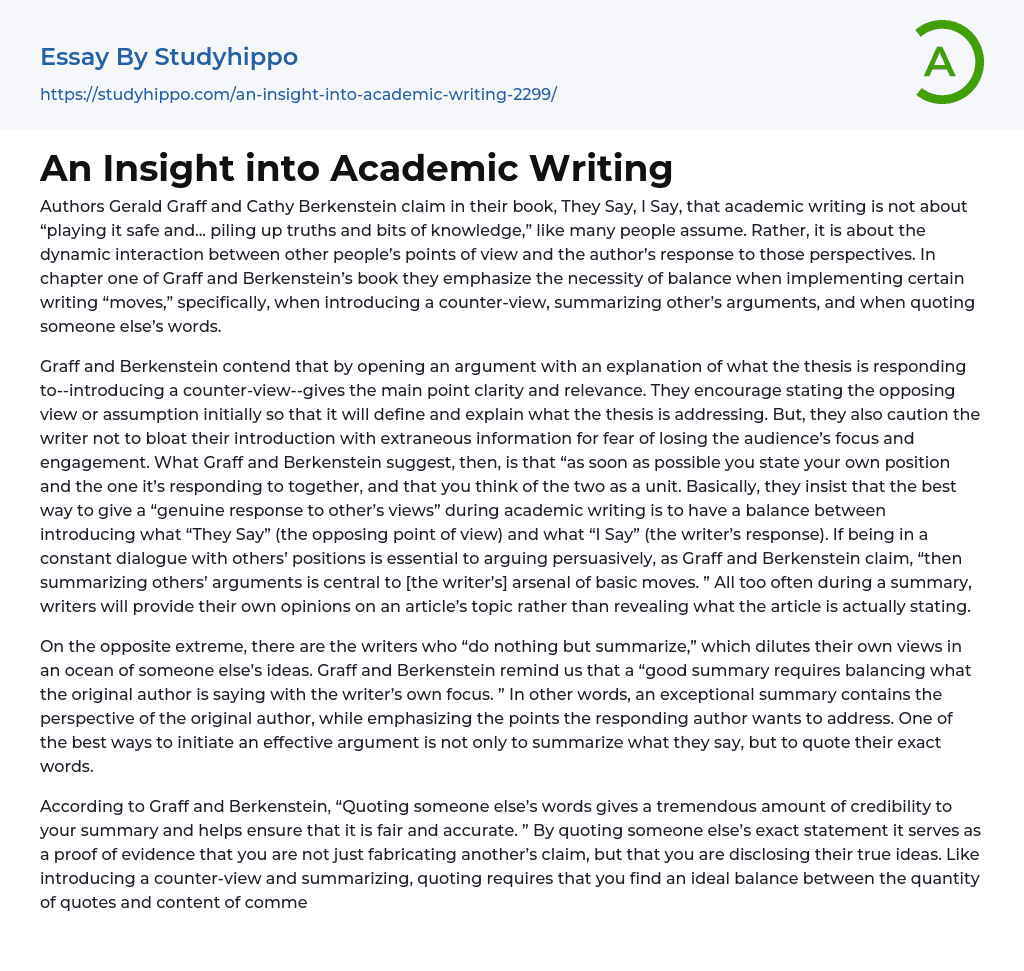Authors Gerald Graff and Cathy Berkenstein claim in their book, They Say, I Say, that academic writing is not about “playing it safe and... piling up truths and bits of knowledge,” like many people assume. Rather, it is about the dynamic interaction between other people’s points of view and the author’s response to those perspectives. In chapter one of Graff and Berkenstein’s book they emphasize the necessity of balance when implementing certain writing “moves,” specifically, when introducing a counter-view, summarizing other’s arguments, and when quoting someone else’s words.
Graff and Berkenstein contend that by opening an argument with an explanation of what the thesis is responding to--introducing a counter-view--gives the main point clarity and relevance. They encourage stating the opposing view or assumption initially so that it will define and explain wha
...t the thesis is addressing. But, they also caution the writer not to bloat their introduction with extraneous information for fear of losing the audience’s focus and engagement. What Graff and Berkenstein suggest, then, is that “as soon as possible you state your own position and the one it’s responding to together, and that you think of the two as a unit. Basically, they insist that the best way to give a “genuine response to other’s views” during academic writing is to have a balance between introducing what “They Say” (the opposing point of view) and what “I Say” (the writer’s response). If being in a constant dialogue with others’ positions is essential to arguing persuasively, as Graff and Berkenstein claim, “then summarizing others’ arguments is central to [the writer’s] arsenal of basic moves. ” All too often during a summary, writers will provide thei
own opinions on an article’s topic rather than revealing what the article is actually stating.
On the opposite extreme, there are the writers who “do nothing but summarize,” which dilutes their own views in an ocean of someone else’s ideas. Graff and Berkenstein remind us that a “good summary requires balancing what the original author is saying with the writer’s own focus. ” In other words, an exceptional summary contains the perspective of the original author, while emphasizing the points the responding author wants to address. One of the best ways to initiate an effective argument is not only to summarize what they say, but to quote their exact words.
According to Graff and Berkenstein, “Quoting someone else’s words gives a tremendous amount of credibility to your summary and helps ensure that it is fair and accurate. ” By quoting someone else’s exact statement it serves as a proof of evidence that you are not just fabricating another’s claim, but that you are disclosing their true ideas. Like introducing a counter-view and summarizing, quoting requires that you find an ideal balance between the quantity of quotes and content of commentary.
A common issue with quoting is when the author assumes the quote speaks for itself. As Graff and Berkenstein, quotes are like literary orphans that have been taken from their original context, “they need to be integrated into their new textual surroundings. ” In simpler terms, a quote needs to be introduced, interpreted, and then connected to the central idea. I found chapter one of Graff and Berkenstein’s book, “They Say,” to be extremely interesting and useful. The way they tied all their information to a central idea,
while explaining how to do just that fascinated me.
I felt like their writing had a constant flow from introduction of a move, to implementing balance, to common problems, how to fix those problems, and then to exercises that would reinforce their primary concepts. Their style and content kept me engaged and focused. Also, I learned a handful of writing tactics, like introducing a counter-view, summarizing, and inserting quotes, that I was not one-hundred percent sure on how to do prior to the reading. Overall, I found the chapter to be engaging, informative, and beneficial to me and my writing style.
- Academic Degree essays
- Academic Dishonesty essays
- Academic writing essays
- Cheating essays
- School Uniform essays
- John Locke essays
- 9/11 essays
- A Good Teacher essays
- A Healthy Diet essays
- A Modest Proposal essays
- A&P essays
- Academic Achievement essays
- Achievement essays
- Achieving goals essays
- Admission essays
- Advantages And Disadvantages Of Internet essays
- Alcoholic drinks essays
- Ammonia essays
- Analytical essays
- Ancient Olympic Games essays
- APA essays
- Arabian Peninsula essays
- Argument essays
- Argumentative essays
- Art essays
- Atlantic Ocean essays
- Auto-ethnography essays
- Autobiography essays
- Ballad essays
- Batman essays
- Binge Eating essays
- Black Power Movement essays
- Blogger essays
- Body Mass Index essays
- Book I Want a Wife essays
- Boycott essays
- Breastfeeding essays
- Bulimia Nervosa essays
- Business essays
- Business Process essays
- Canterbury essays
- Carbonate essays
- Catalina de Erauso essays
- Cause and Effect essays
- Cesar Chavez essays
- Character Analysis essays
- Chemical Compound essays
- Chemical Element essays
- Chemical Substance essays
- Cherokee essays




